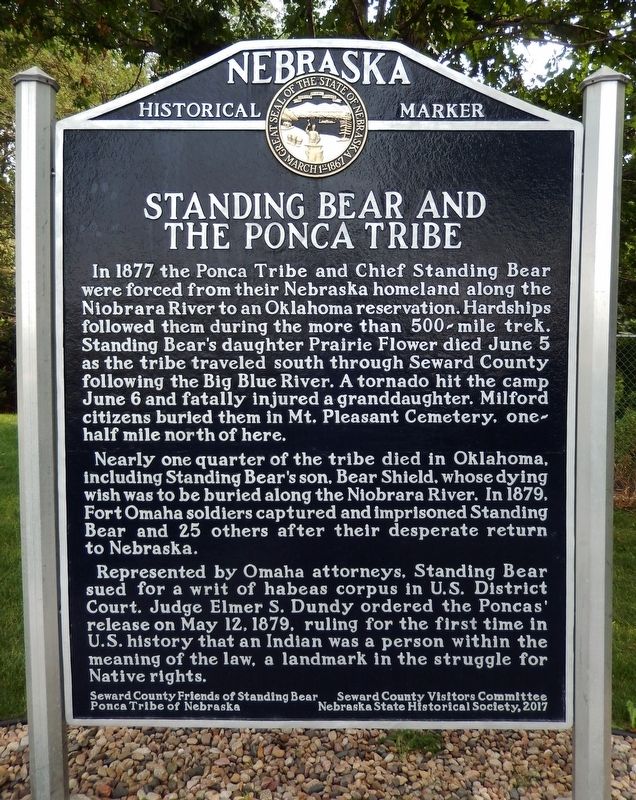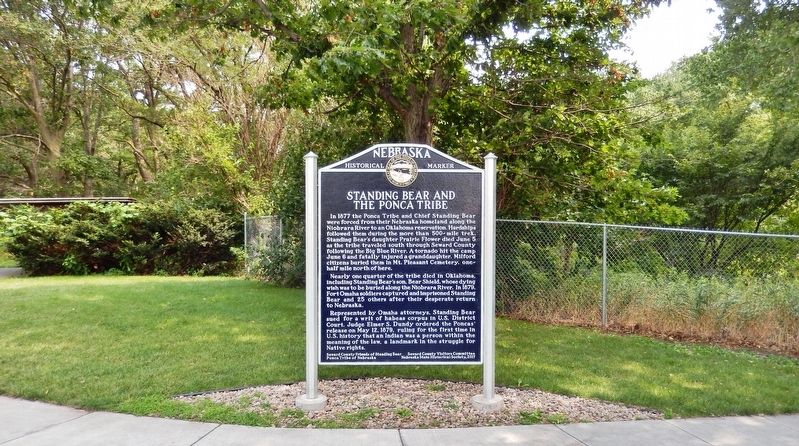Near Milford in Seward County, Nebraska — The American Midwest (Upper Plains)
Standing Bear and the Ponca Tribe
Nearly one quarter of the tribe died in Oklahoma, including Standing Bearís son, Bear Shield, whose dying wish was to be buried along the Niobrara River. In 1879, Fort Omaha soldiers captured and imprisoned Standing Bear and 25 others after their desperate return to Nebraska.
Represented by Omaha attorneys, Standing Bear sued for a writ of habeas corpus in U.S. District Court. Judge Elmer S. Dundy ordered the Poncasí release on May 12, 1879, ruling for the first time in U.S. history that an Indian was a person within the meaning of the law, a landmark in the struggle for Native rights.
Erected 2017 by Seward County Friends of Standing Bear; Ponca Tribe of Nebraska; Seward County Visitors Committee; and Nebraska State Historical Society. (Marker Number 535.)
Topics and series. This historical marker is listed in these topic lists: Civil Rights • Law Enforcement • Native Americans. In addition, it is included in the Nebraska State Historical Society series list. A significant historical year for this entry is 1877.
Location. 40° 49.277′ N, 97° 3.621′ W. Marker is near Milford, Nebraska, in Seward County. Marker can be reached from Interstate 80 at milepost 381,, 2 miles east of Exit 379 (State Highway 15), on the right when traveling east. Marker is located in the Interstate 80 East Rest Area. Touch for map. Marker is in this post office area: Milford NE 68405, United States of America. Touch for directions.
Other nearby markers. At least 8 other markers are within 13 miles of this marker, measured as the crow flies. Tall Grass Prairie (within shouting distance of this marker); The Big Blue River (within shouting distance of this marker); Purple Heart Trail (within shouting distance of this marker); Historic Milford (approx. 3.4 miles away); Big Blue River, Seward (approx. 5.8 miles away); Plum Creek Prairie Historic Site (approx. 5.8 miles away); Seward, 4th of July City (approx. 6.3 miles away); PFC Charley Havlat (approx. 12.6 miles away). Touch for a list and map of all markers in Milford.
Related markers. Click here for a list of markers that are related to this marker. Chief Standing Bear
Also see . . .
1. Chief Standing Bear. From his birth on the banks of the Niobrara River in Nebraska until his death in 1908, Chief Standing Bear spent his life in constant struggle to gain equality and justice for our nationís Native Americans. In 1877, Chief Standing Bear and the Ponca Tribe were forced by a federal treaty to leave their homeland in Nebraska for Indian Territory in what is now Oklahoma. Chief Standing Bear became the first Native American to be recognized as a person in a federal court decision. (Submitted on August 13, 2021, by Cosmos Mariner of Cape Canaveral, Florida.)
2. Trial of Standing Bear. The Ponca were forcibly removed from their homeland in northeastern Nebraska and marched to Indian Territory in Oklahoma. Many died along the way, including Standing Bearís daughter, and, upon arrival, his son would also die. Promising to honor his sonís dying wish to be buried in his homeland, Standing Bear and a small band of his men began the arduous journey home to bury his son. They were soon arrested and about to be returned to Indian Territory when their plight was publicized in the Omaha Daily Herald. (Submitted on August 13, 2021, by Cosmos Mariner of Cape Canaveral, Florida.)
Credits. This page was last revised on August 13, 2021. It was originally submitted on August 13, 2021, by Cosmos Mariner of Cape Canaveral, Florida. This page has been viewed 290 times since then and 38 times this year. Photos: 1, 2. submitted on August 13, 2021, by Cosmos Mariner of Cape Canaveral, Florida.

